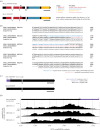A standard workflow for community-driven manual curation of Strongyloides genome annotations
- PMID: 38008112
- PMCID: PMC10676816
- DOI: 10.1098/rstb.2022.0443
A standard workflow for community-driven manual curation of Strongyloides genome annotations
Abstract
Advances in the functional genomics and bioinformatics toolkits for Strongyloides species have positioned these species as genetically tractable model systems for gastrointestinal parasitic nematodes. As community interest in mechanistic studies of Strongyloides species continues to grow, publicly accessible reference genomes and associated genome annotations are critical resources for researchers. Genome annotations for multiple Strongyloides species are broadly available via the WormBase and WormBase ParaSite online repositories. However, a recent phylogenetic analysis of the receptor-type guanylate cyclase (rGC) gene family in two Strongyloides species highlights the potential for errors in a large percentage of current Strongyloides gene models. Here, we present three examples of gene annotation updates within the Strongyloides rGC gene family; each example illustrates a type of error that may occur frequently within the annotation data for Strongyloides genomes. We also extend our analysis to 405 previously curated Strongyloides genes to confirm that gene model errors are found at high rates across gene families. Finally, we introduce a standard manual curation workflow for assessing gene annotation quality and generating corrections, and we discuss how it may be used to facilitate community-driven curation of parasitic nematode biodata. This article is part of the Theo Murphy meeting issue 'Strongyloides: omics to worm-free populations'.
Keywords: Strongyloides; WormBase; community curation; comparative genomics; genome annotation; nematodes.
Conflict of interest statement
The authors declare no competing interests.
Figures



Similar articles
-
Advancing Strongyloides omics data: bridging the gap with Caenorhabditis elegans.Philos Trans R Soc Lond B Biol Sci. 2024 Jan 15;379(1894):20220437. doi: 10.1098/rstb.2022.0437. Epub 2023 Nov 27. Philos Trans R Soc Lond B Biol Sci. 2024. PMID: 38008117 Free PMC article. Review.
-
WormBase 2016: expanding to enable helminth genomic research.Nucleic Acids Res. 2016 Jan 4;44(D1):D774-80. doi: 10.1093/nar/gkv1217. Epub 2015 Nov 17. Nucleic Acids Res. 2016. PMID: 26578572 Free PMC article.
-
Novel and improved Caenorhabditis briggsae gene models generated by community curation.bioRxiv [Preprint]. 2023 May 18:2023.05.16.541014. doi: 10.1101/2023.05.16.541014. bioRxiv. 2023. Update in: BMC Genomics. 2023 Aug 25;24(1):486. doi: 10.1186/s12864-023-09582-0. PMID: 37292880 Free PMC article. Updated. Preprint.
-
Syntenic relationship of chromosomes in Strongyloides species and Rhabditophanes diutinus based on the chromosome-level genome assemblies.Philos Trans R Soc Lond B Biol Sci. 2024 Jan 15;379(1894):20220446. doi: 10.1098/rstb.2022.0446. Epub 2023 Nov 27. Philos Trans R Soc Lond B Biol Sci. 2024. PMID: 38008120 Free PMC article.
-
Strongyloides questions-a research agenda for the future.Philos Trans R Soc Lond B Biol Sci. 2024 Jan 15;379(1894):20230004. doi: 10.1098/rstb.2023.0004. Epub 2023 Nov 27. Philos Trans R Soc Lond B Biol Sci. 2024. PMID: 38008122 Free PMC article. Review.
Cited by
-
Invade or die: behaviours and biochemical mechanisms that drive skin penetration in Strongyloides and other skin-penetrating nematodes.Philos Trans R Soc Lond B Biol Sci. 2024 Jan 15;379(1894):20220434. doi: 10.1098/rstb.2022.0434. Epub 2023 Nov 27. Philos Trans R Soc Lond B Biol Sci. 2024. PMID: 38008119 Free PMC article. Review.
-
Dopamine signaling drives skin invasion by human-infective nematodes.Nat Commun. 2025 Aug 13;16(1):7246. doi: 10.1038/s41467-025-62517-z. Nat Commun. 2025. PMID: 40804046 Free PMC article.
-
Strongyloides: omics to worm-free populations.Philos Trans R Soc Lond B Biol Sci. 2024 Jan 15;379(1894):20220448. doi: 10.1098/rstb.2022.0448. Epub 2023 Nov 27. Philos Trans R Soc Lond B Biol Sci. 2024. PMID: 38008116 Free PMC article.
-
Dopamine signaling drives skin invasion by human-infective nematodes.bioRxiv [Preprint]. 2025 Jan 30:2025.01.29.635547. doi: 10.1101/2025.01.29.635547. bioRxiv. 2025. Update in: Nat Commun. 2025 Aug 13;16(1):7246. doi: 10.1038/s41467-025-62517-z. PMID: 39974984 Free PMC article. Updated. Preprint.
References
MeSH terms
Grants and funding
LinkOut - more resources
Full Text Sources
Research Materials

